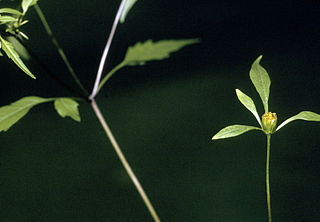
Cirsium arizonicum, the Arizona thistle, is a North American species of thistle in the family Asteraceae, native to the southwestern United States and northwestern Mexico. It has been found in Arizona, southeastern California, New Mexico, Nevada, Colorado, Utah, Sonora, and northwestern Chihuahua.

Ericameria laricifolia is a North American species of flowering shrub in the family Asteraceae known by the common name turpentine bush, or turpentine-brush. It is native to the southwestern United States and northern Mexico (Chihuahua).

Hymenoxys hoopesii is a species of flowering plant in the daisy family known by the common names owl's claws, orange sneezeweed, and yerba del lobo. It is native to the western United States, where it grows in habitats of moderate elevation, such as mountain meadows in the Rocky Mountains, Sierra Nevada, southern Cascades, and other ranges. It has been found from Arizona, New Mexico, and central California north as far as Montana and Oregon.

Thelesperma, commonly known as greenthreads, is a genus of annual or perennial herbs and subshrubs found in the Americas. Members of this genus are closely related to some species of Coreopsis and Bidens. The genus is considered to be within the family Asteraceae.

Thelesperma megapotamicum is a perennial, herbaceous, flowering plant in the Asteraceae family native to sections of the Americas. It is known by the common names Hopi tea greenthread, rayless greenthread, Navajo tea, cota, and greenthread.

Bidens aristosa, known by many common names such as bearded beggarticks, western tickseed, showy tickseed, long-bracted beggarticks, tickseed beggarticks, swamp marigold, and Yankee lice, is an herbaceous, annual plant in the Asteraceae family. It is native to the central United States, but has been introduced to the eastern United States, Canada, France, Great Britain, and India. It grows in marshes, meadows, pine forests and disturbed sites.

Cosmos parviflorus, commonly known as the southwestern cosmos, is an annual, herbaceous, flowering plant in the Asteraceae family. It is native to parts of the Southwestern United States and most of Mexico and appears to be introduced in portions of the Northeastern United States.

Bidens bidentoides, commonly called swamp beggar's-ticks and delmarva beggarticks, is an annual, herbaceous, flowering plant in the Asteraceae family. It is native to the northeastern and east-central parts of the United States, the coastal plain of the States of Maryland, Delaware, Pennsylvania, and New Jersey plus the region around the Hudson River estuary in New York.

Bidens bigelovii, commonly called Bigelow's beggarticks, is an annual herbaceous flowering plant in the Asteraceae family. It is native to the southwestern and south-central United States and as far south as Oaxaca, Mexico.

Bidens discoidea, commonly known as small beggarticks, is an annual, herbaceous, flowering plant in the Asteraceae family. It is widespread across eastern Canada and the eastern and central United States, from Nova Scotia west to Minnesota, south to Florida and Texas.
Bidens lemmonii is a North American species of flowering plant in the family Asteraceae. It is native to the southwestern United States and Mexico.
Bidens leptocephala, commonly known as the fewflower beggarticks, is an annual herbaceous flowering plant in the Asteraceae family. It is native to the southwestern United States and northern Mexico.

Brickellia floribunda, the Chihuahuan brickellbush, is a North American species of flowering plants in the family Asteraceae. It is native to northern Mexico and the south-western United States.

Carphochaete bigelovii, common name Bigelow's bristlehead, is a species of North American flowering plants in the family Asteraceae. They are native to northern Mexico and the southwestern United States.
Encelia scaposa, common name onehead brittlebush is a North American species of flowering plants in the family Asteraceae. It has been found in western Texas, southwestern New Mexico, and Chihuahua.
Zinnia anomala is a North American species of flowering plants in the family Asteraceae, with the common name shortray zinnia. It is native to western Texas in the United States and also to the States of Coahuila, Nuevo León, and Zacatecas in northern Mexico.
Guardiola platyphylla, the Apache plant, is a North American species of plants in the family Asteraceae, native to Mexico and the southwestern United States. It is found in northwestern Mexico and the southwestern United States.

Hymenothrix wrightii, commonly known as Wright's hymenothrix or Wright's thimblehead, is a North American species of flowering plant in the daisy family. It grows in northwestern Mexico and the southwestern United States.

Symphyotrichum chapmanii is a species of flowering plant in the family Asteraceae native to the Apalachicola River drainage basin of Alabama and Florida. Commonly known as savanna aster, it is a perennial, herbaceous plant that may reach 30 to 80 centimeters tall. Its flowers have purple to blue-lavender ray florets and pale yellow disk florets. It is a wetland species and is of conservation concern. It may be extirpated in Alabama.

Thelesperma simplicifolium, commonly known as the slender greenthread, is a perennial, herbaceous, flowering plant in the Asteraceae family. It is found from Texas and Mexico in openings in oak or juniper woodlands or on desert scrub.















